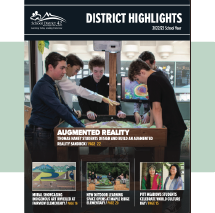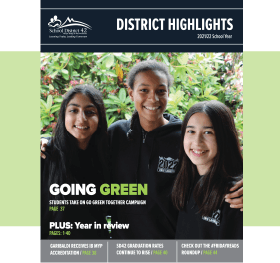Above: A tasting demonstration of teas made from native plants used by First Peoples as remedies for minor ailments.
One of the highlights of BC’s redesigned curriculum is the integration of Aboriginal culture and perspectives into all subject areas.
In mid-February, Maple Ridge – Pitt Meadows School District instructional staff gathered for the second of two mandated training days designed to support the implementation of BC’s new curriculum.
A variety of courses and planning sessions for the new curriculum took place at locations across the district, including a workshop titled “Science First Peoples Grades 5-9” hosted at Thomas Haney Secondary.
Led by Jessica Knott, Aboriginal resource teacher, and Kirsten Urdahl-Serr, secondary helping teacher – innovations, the session explored First Peoples pedagogy and scientific perspectives, the convergence of First Peoples connections with contemporary science and Traditional Ecological Knowledge (TEK).
“The resources that have been put together are astonishing. The textbook that we gave teachers, Science First Peoples Grades 5-9, is a fantastic resource guide,” said Urdahl-Serr. “The intention is for it to be used as a starting point for teachers to build their own integrated teaching plan with other subjects. There are tons and tons of resources embedded in this book.”
During the interactive workshop, one of the main talking points was the notion of “convergence.”
“How do we converge Aboriginal perspectives with Western science perspectives?” explained Urdahl-Serr. “So we’re really focusing on the fact that it’s Science First Peoples – what are the key differences, and how are they the same?”
“The concept of interconnectedness is first and foremost in the teaching of Aboriginal people. It’s just such a different perspective around honouring what the land gives you and ensuring that you don’t take more than you need,” she added. “One of the key differences is that First Peoples is more of a holistic point of view, that interconnectedness, whereas Western science is more categorized.”
Knott noted that it was exciting to see the teachers engage with material at a deeper level.
“We had an interesting discussion breaking down First Peoples perspectives and ways of knowing and comparing them to Western perspectives. Throughout the day there were a number of ‘a ha’ moments.”
During the session, five stations were set up to allow teachers to interact with some of the activities found in the textbook, including a tasting demonstration of teas made from native plants used by First Peoples as remedies for minor ailments.
“What we’re saying to teachers is you can do these activities in any classroom and align it to the BC science curriculum. You could do it as a standalone as sort of an entry point into First Peoples perspective, just a single activity, or as an entire interdisciplinary plan,” said Urdahl-Serr.
Along with receiving a copy of the Science First Peoples Grades 5-9 teacher resource guide, attendees also had the opportunity to learn more about the resources available through the SD42 AbEd library.
Knott said her department has spent the last year developing a library for students, teachers, and the community filled with authentic Aboriginal resources.
“We have everything from picture books, to novels, to teacher resources, to DVDs,” explained Knott. “We have also begun the process of developing kits that teachers can use within their classrooms. We have currently completed a Residential School resource kit for Grade 5 and Grade 10. Through the development of the First Peoples science workshop, we also developed a kit for ethnobotany, which can be used from K-12, and we aim to complete a few other units by the beginning of April.”
The curriculum implementation day at SD42 was jointly planned by a committee of district helping teachers, Maple Ridge Teachers’ Association, CUPE, Maple Ridge Principals’ and Vice Principals’ Association executive members and district leadership staff.
To learn more about the implementation of BC’s redesigned curriculum, click here.


